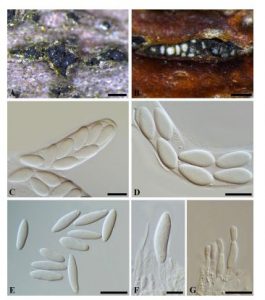Botryosphaeria rosaceae Y.P. Zhou, Y. Zhang ter., sp. nov. MycoBank number: 817187
Etymology: The epithet rosaceae refers to the hosts within the family Rosaceae from which this species was isolated.
Ascostroma erumpent. Ascomata brown to black, 170–290 μm diam, pseudothecial, forming a botryose aggregate of up to 15, sometimes solitary, globose with a central ostiole, ¼ to ½ emergent, rarely embedded, with or without papilla. Wall pseudothecial, composed of 8–14 layers of textura angularis, outer region of dark brown cells, inner region of 2–4 layers of hyaline cells lining the locule. Pseudoparaphyses filiform, septate, constricted at the septa, rarely branched, 2–4 μm wide. Asci bitunicate, clavate, 87–125 × 22–26 μm. Ascospores ellipsoidal to fusiform, hyaline, thin-walled, sometimes with tapered ends and appearing spindle-shaped, biseriate in the ascus, 22–31(–35) × 8–13(–15) μm (x = 26.1 × 10.8 μm, n = 30), L/W = 2.4. Conidiomata stromatic, morphologically indistinguishable from the ascomata. Paraphyses, hyaline, septate, up to 55 μm long, 5–6 μm wide at the base tapering to acutely rounded apices, 2–2.5 μm wide at the tip. Conidiogenous cells cylindrical to lageniform, hyaline, smooth, thin-walled, producing a single conidium at the tip, rarely proliferating at the same level giving rise to periclinal thickenings, 6–15 × 2.5–5 μm. Conidia hyaline, narrowly fusiform, or irregularly fusiform, base subtruncate to bluntly rounded, 20–31 × 6–8 μm (x = 26.2 × 6.7 μm, n = 30), L/W = 3.9, aged conidia not observed. Spermatogenous cells hyaline, thin-walled, smooth, 8–11 × 2–4 μm, producing conidia at their tips, proliferating internally to form periclinal thickenings. Spermatia rod-shaped with obtuse ends, hyaline, thin-walled, smooth, 5–8 × 1.5–3 μm.
Culture characteristics : Colonies initially white turning grey olivaceous from the middle of colonies after 4 d, becoming smoke grey to olivaceous grey on the surface and olivaceous green to black underneath within 7–10 d in the dark at 28℃.
Material examined : CHINA, Shandong Province, Yantai, Laishan, on twigs of Malus sp. (Rosaceae), 19 May 2015, Y Zhang & JQ Zhang (holotype HMAS 246964), ex-type culture CGMCC3.18007; Qixia, on twigs of Amygdalus sp. (Rosaceae), 19 May 2015, leg. Y Zhang, JQ Zhang & ZP Dou (paratype, HMAS 246965), isolate CGMCC3.18008; Henan Province, Puyang, Qingfeng County, on twigs of Pyrus sp. (Rosaceae), 10 November 2014, leg. ZP Dou (paratype, HMAS 246966), isolate CGMCC3.18009; on twigs of Pyrus sp. (Rosaceae), 10 November 2014, leg. ZP Dou (paratype, HMAS 246967), isolate CGMCC3.18010.
Notes : Morphologically, B. rosaceae was most comparable to B. sinensia, but the smaller and more slender ascospores and conidia of B. sinensia differentiate this species from B. rosaceae. Phylogenetic analyses based on combined ITS, LSU, TUB and tef1-a sequences indicated that B. rosaceae and B. sinensia are separate species.
FIG 2. Botryosphaeria rosaceae. A Botryose clusters of ascomata erumpent through the bark of an Amygdalus sp. twig (HMAS 246965, paratype); B Transverse section through ascomata revealing brilliant white contents; C Asci with ascospores; D Ascospores; E Conidia; F Conidia developing on conidiogenous cells; G Branched spermatogenous cells and developing spermatia. –Bars: A, B = 0.5 mm, C−E= 20 μm, F, G= 10 μm.

